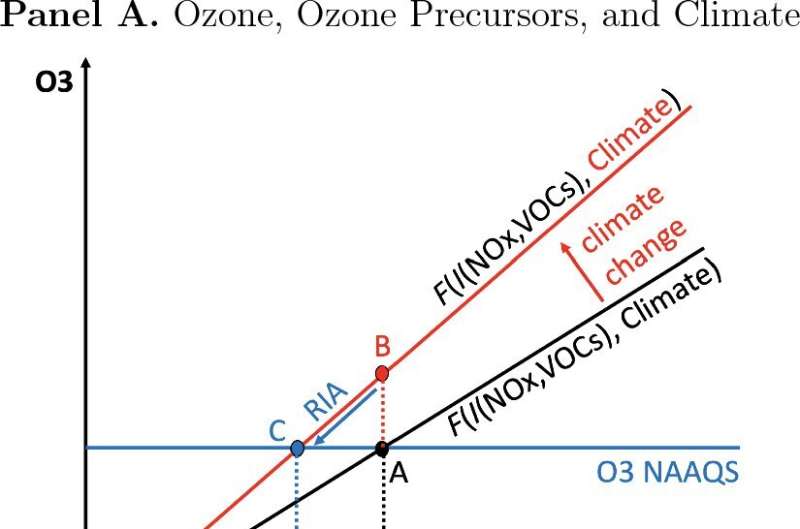This article has been reviewed according to Science X's editorial process and policies. Editors have highlighted the following attributes while ensuring the content's credibility:
fact-checked
trusted source
proofread
Studies highlight new approaches to addressing climate change

Failing to achieve climate mitigation goals puts increasing pressure on climate adaptation strategies. In two new studies, researchers address novel approaches to these issues.
In the first study, researchers developed an approach to measure climate impacts and adaptation that considers responses to weather shocks and longer-term climatic changes. They used this approach to examine the impact of climate change on ambient '"bad" ozone areas in U.S. counties from 1980 to 2013, identifying possible biases in existing approaches.
In the second study, researchers developed an analytical framework to examine interactions between climate change and existing policy governing issues unrelated to climate change. They show that when climate change exacerbates a market failure, the existing policy triggers an adaptive response, reducing climate impacts. This study also examined U.S. counties, showing that ambient ozone areas increased with rising temperatures, but that such increases were mitigated in counties out of attainment with the Clean Air Act standards.
Both studies were conducted by researchers at Carnegie Mellon University (CMU), the University of Southern California, and Zayed University. The first study appears in the Journal of Environmental Economics and Management; the second is published in Environmental and Resource Economics.
"Those seeking to develop efficient climate policies must understand how to adapt to a changing climate," says Edson Severnini, associate professor of economics and public policy at CMU's Heinz College, who coauthored the studies. "Faced with the political challenges of creating new, first-best climate policies; the urgency to address climate change; and the slow pace of market-based adaptation, it may be relatively easier in the short-run to adjust existing policy to maximize adaptation benefits while working toward comprehensive climate policy."
The first study compared how economic agents in the same season and location responded to weather shocks with their own response to climatic changes, which should incorporate adaptive behavior. Researchers applied their novel unifying approach to the context of daily temperature and ambient ozone concentration across the continental United States, merging location-by-day ozone concentration data with temperature data from 1980 to 2013.
By bridging two earlier strands of climate-economy literature, the study overcame identification concerns from earlier cross-sectional studies; improved on the measurement of adaptation; and provided a test for the statistical significance of this measure. Using their new approach, the researchers came to four conclusions:
- A changing climate appeared to affect ambient ozone concentrations.
- There was strong evidence of adaptive behavior.
- By extending the model to recover estimates accounting for the nonlinear relationship between ozone and temperature, agents tended to focus their adaptive efforts on the hottest days, which would likely lead to higher levels of ambient ozone.
- The study highlights the potential biases of existing approaches in assigning weather responses or adaptation from one period or location to other periods and locations.
When a non-climate institution, policy, or regulation corrects a pre-existing market failure that would be exacerbated by climate change, it may also incidentally induce climate adaptation. This regulation-induced adaptation can have large welfare effects. In their second study, the researchers' development and use of a new analytical framework allowed them to credibly estimate regulation-induced adaptation. Among the study's findings:
- Adaptation in nonattainment counties reduced the impact of a 1°C rise in climate normal temperature on ozone concentration by nearly a third of total impact.
- Comparing the adaptive response to long-run climatic changes in temperature between counties in or out of attainment with the Clean Air Act's National Ambient Air Quality Standard (NAAQS) for ambient ozone revealed an adaptive response more than twice as large in nonattainment counties.
- This regulation-induced adaptation had non-trivial welfare effects, implying an additional benefit of the ozone NAAQS of up to $471 million a year by 2050.
"The NAAQS for ozone is an ideal setting for examining regulation-induced adaptation because of its direct policy relevance and because climate change is expected to increase ozone concentrations in the near future," explains Antonio M. Bento, professor of economics at USC's Sol Price School of Public Policy, who coauthored both studies. "By highlighting an additional benefit of the NAAQS that had previously been unaccounted for, our findings may contribute to the design or revision of pollution control policy."
More information: Antonio M. Bento et al, A unifying approach to measuring climate change impacts and adaptation, Journal of Environmental Economics and Management (2023). DOI: 10.1016/j.jeem.2023.102843
Antonio M. Bento et al, Incidental Adaptation: The Role of Non-climate Regulations, Environmental and Resource Economics (2023). DOI: 10.1007/s10640-023-00793-3
Provided by Carnegie Mellon University




















